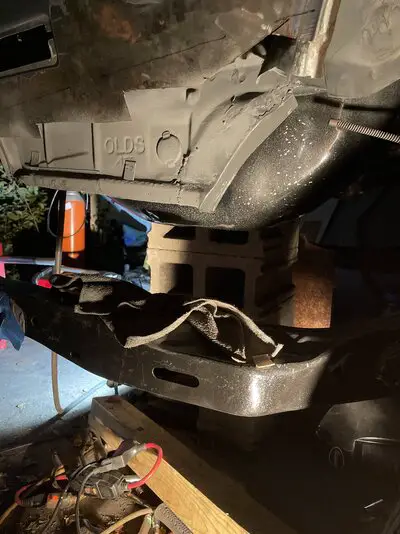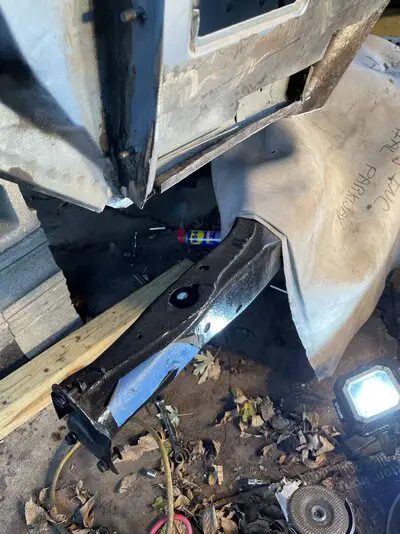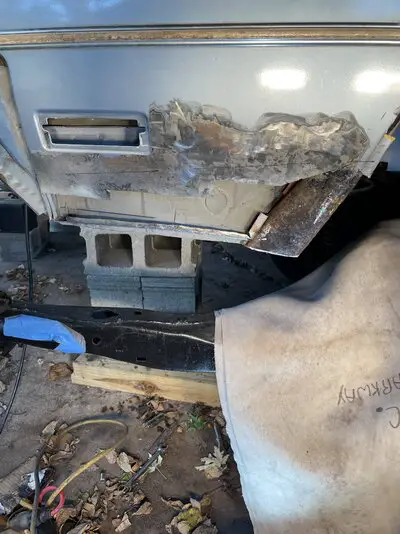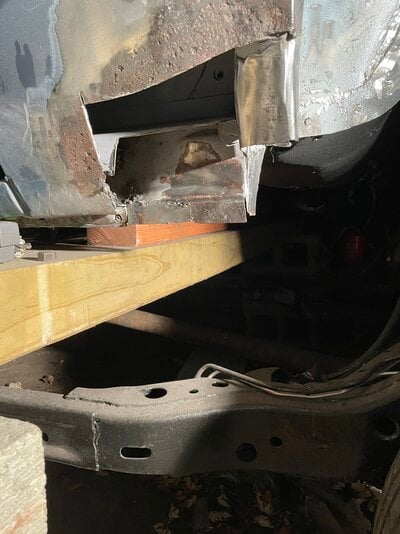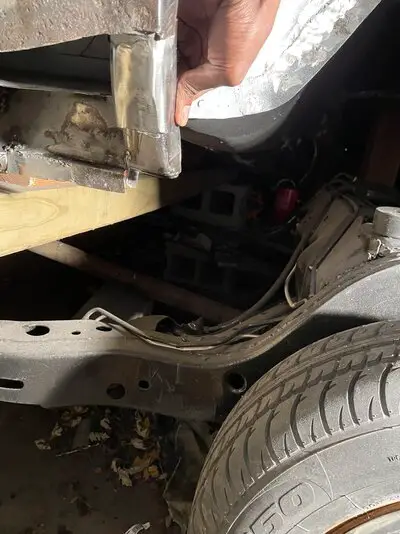Quarter Panel Body work…
- Thread starter Hotboyrn84
- Start date
You are using an out of date browser. It may not display this or other websites correctly.
You should upgrade or use an alternative browser.
You should upgrade or use an alternative browser.
- Status
- Not open for further replies.
Hotboyrn84, from experience, I know you have a huge mess on your hands. A big project but not impossible! My 87 which is also a 5th Gen El Camino had body rust extending from the back lower corner of each door to the bottom of the tailgate. Because the rust was so extensive and involved the sealed chamber between the inner body shell and outer panel from the door to the front of the wheel wells, I concluded that a previous owner had been launching boats with this EC. Submersion was the only way water could intrude into this sealed area.


The pink compound you've encountered can be found throughout the body of our vehicles. It is not only down low but also higher like at the corners/base of the windshield where the windshield channel intersects the A-pillar. As someone previously mentioned, it is a weld-thru seam sealer that is LIBERALLY applied especially where multiple panels (I've counted up to 5 panels) are pinch welded to construct the body. Let me say that peeling back and separating the metal layers was a chore and no easy task. Because I tend to be a perfectionist, I opted to fix these areas like any restoration garage would--drill out any and all spot welds I found then separating each layers. Once the spot welds were drilled, I used a heat gun to soften the seam sealer. Softening the seam sealer was key to allow a flat Steck seam buster to slide in-between and separate each panel layer.
I note you're opting to retain as much of the original metal structures since you do not have replacements for these. Let me share with you how I addressed this dilemma; I ended up buying a 79 Pontiac Station Wagon and an 84 El Camino from which I scavenged replacement pieces. I was very fortunate to obtain both of these for $500 each and able to recoup my investment by selling off parts. Doing replacement of these inner pieces is important since many are involved in the structural integrity of the body, especially the seam that runs along the bottom length of the vehicle. Welding solid pieces is absolutely necessary! I offer this precaution: as you progress with the inner structures always be mindful of whether or not the outer panel fits properly. You don't want to weld it all up and later find out the skin panel doesn't line up and looks bad.

I post a few shots of the finished areas later when I find them.
Good luck and go slow!


The pink compound you've encountered can be found throughout the body of our vehicles. It is not only down low but also higher like at the corners/base of the windshield where the windshield channel intersects the A-pillar. As someone previously mentioned, it is a weld-thru seam sealer that is LIBERALLY applied especially where multiple panels (I've counted up to 5 panels) are pinch welded to construct the body. Let me say that peeling back and separating the metal layers was a chore and no easy task. Because I tend to be a perfectionist, I opted to fix these areas like any restoration garage would--drill out any and all spot welds I found then separating each layers. Once the spot welds were drilled, I used a heat gun to soften the seam sealer. Softening the seam sealer was key to allow a flat Steck seam buster to slide in-between and separate each panel layer.
I note you're opting to retain as much of the original metal structures since you do not have replacements for these. Let me share with you how I addressed this dilemma; I ended up buying a 79 Pontiac Station Wagon and an 84 El Camino from which I scavenged replacement pieces. I was very fortunate to obtain both of these for $500 each and able to recoup my investment by selling off parts. Doing replacement of these inner pieces is important since many are involved in the structural integrity of the body, especially the seam that runs along the bottom length of the vehicle. Welding solid pieces is absolutely necessary! I offer this precaution: as you progress with the inner structures always be mindful of whether or not the outer panel fits properly. You don't want to weld it all up and later find out the skin panel doesn't line up and looks bad.

I post a few shots of the finished areas later when I find them.
Good luck and go slow!

I've been waiting for a picture like this to show up,does any one know what the h*ll that rod that's welded inside the panel is for?????? I've seen them a bunch of times and have never been able to figure out it's purpose.☕

Last edited by a moderator:
Same here as I thought the Buick trunk floor I bought has them too.
I've been waiting for a picture like this to show up,does any one know what the h*ll that rod that's welded inside the panel is for?????? I've seen them a bunch of times and have never been able to figure out it's purpose.☕
Last edited by a moderator:
I asked that question the other day to someone else who was also working on this area of our cars. His answer was...the rod is coated with some kind of wax sealant and held to the inside of the panel with the square adhesive pads. Since the automotive manufacturing industry had not yet evolved to dipping whole parts, the heat from welding the panels together would melt the wax sealant which then drained into the bottom seam to seal the intersection of the panels from the inside. Hopefully, this explanation suffices.
I want to seal my repairs from the inside and will do so after painting. I have to wait since most sealants have chemicals which will negatively effect paint jobs by creating fisheyes. So, I plan to use the round 1.5" hole (visible in the inner panel) to spray some type of cavity sealant/sealer.
I want to seal my repairs from the inside and will do so after painting. I have to wait since most sealants have chemicals which will negatively effect paint jobs by creating fisheyes. So, I plan to use the round 1.5" hole (visible in the inner panel) to spray some type of cavity sealant/sealer.
Last edited:
Not saying that isn't the reason, but, doesn't sound right... I mean, they could accomplish the same thing by just putting a thicker coat of wax on the panels being welded and let it drip down.I asked that question the other day to someone else who was also working on this area of our cars. His answer was...the rod is coated with some kind of wax sealant and held to the inside of the panel with the square adhesive pads. Since the automotive manufacturing industry had not yet evolved to dipping whole parts, the heat from welding the panels together would melt the wax sealant which then drained into the bottom seam to seal the intersection of the panels from the inside. Hopefully, this explanation suffices.
I want to seal my repairs from the inside and will do so after painting. I have to wait since most sealants have chemicals which will negatively effect paint jobs by creating fisheyes. So, I plan to use the round 1.5" hole (visible in the inner panel) to spray some type of cavity sealant/sealer.
Also, they had whole panel e-coatings before these cars, the earliest forms of the tech started at Ford in the late 1950s, but if you buy nos metal for these cars they come with that familiar black coating on them..
On the flip side, given robotic welding was not yet a thing and these panels were hand aligned and attached wouldn't these make a mounting/alignment point to help hold the panel aligned while welds were being placed? Robotic jigs weren't a thing yet, and, you needed some consistency in these spots considering the roof wasn't on the car yet when the quarters got hung.
Last edited:
Thanks for the pics cause they were definitely a helpful start… I really hope u find pics of what you did here. …
Are the pieces on the ground the original or donor… I’ll post what I’ve done so far tomorrow… It’s definitely been slow cut weld grind stare from all angles adjust repeat…Hotboyrn84, from experience, I know you have a huge mess on your hands. A big project but not impossible! My 87 which is also a 5th Gen El Camino had body rust extending from the back lower corner of each door to the bottom of the tailgate. Because the rust was so extensive and involved the sealed chamber between the inner body shell and outer panel from the door to the front of the wheel wells, I concluded that a previous owner had been launching boats with this EC. Submersion was the only way water could intrude into this sealed area.
View attachment 185396
View attachment 185397
The pink compound you've encountered can be found throughout the body of our vehicles. It is not only down low but also higher like at the corners/base of the windshield where the windshield channel intersects the A-pillar. As someone previously mentioned, it is a weld-thru seam sealer that is LIBERALLY applied especially where multiple panels (I've counted up to 5 panels) are pinch welded to construct the body. Let me say that peeling back and separating the metal layers was a chore and no easy task. Because I tend to be a perfectionist, I opted to fix these areas like any restoration garage would--drill out any and all spot welds I found then separating each layers. Once the spot welds were drilled, I used a heat gun to soften the seam sealer. Softening the seam sealer was key to allow a flat Steck seam buster to slide in-between and separate each panel layer.
I note you're opting to retain as much of the original metal structures since you do not have replacements for these. Let me share with you how I addressed this dilemma; I ended up buying a 79 Pontiac Station Wagon and an 84 El Camino from which I scavenged replacement pieces. I was very fortunate to obtain both of these for $500 each and able to recoup my investment by selling off parts. Doing replacement of these inner pieces is important since many are involved in the structural integrity of the body, especially the seam that runs along the bottom length of the vehicle. Welding solid pieces is absolutely necessary! I offer this precaution: as you progress with the inner structures always be mindful of whether or not the outer panel fits properly. You don't want to weld it all up and later find out the skin panel doesn't line up and looks bad.
View attachment 185398
I post a few shots of the finished areas later when I find them.
Good luck and go slow!
Sorry for taking so long to respond...the parts in the ground are the replacements from a donor vehicle. The rule of thumb I used was to build from the inside out all the while being very mindful of how the inside impacts the final fit of the outer skin. Just be patient and work slowly! Good luck!
Almost happy with the inner quarter repair… hopefully the outer skin is easier
Attachments
- Status
- Not open for further replies.
Similar threads
- Replies
- 1
- Views
- 99
- Replies
- 7
- Views
- 493
GBodyForum is a participant in the Amazon Services LLC Associates Program, an affiliate advertising program designed to provide a means for sites to earn advertising fees by advertising and linking to amazon.com. Amazon, the Amazon logo, AmazonSupply, and the AmazonSupply logo are trademarks of Amazon.com, Inc. or its affiliates.


